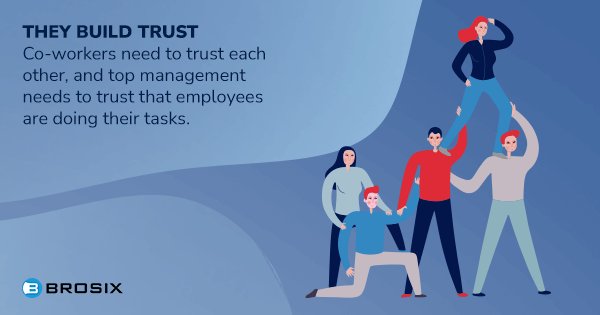Post-pandemic, many organizations have changed their organizational culture and adopted hybrid or fully remote work systems.
Before the COVID-19 pandemic, working a 9-to-5 job and going to the office daily was the norm. Each department had its own designated area, and often higher management had separate offices or were located on the top floor.
Collaboration was easier, as all meetings were held in person. Leaders always knew what employees were doing as they were physically in the same space.
This shift in how we work has massively impacted how organizations manage their teams.
Managing remote or hybrid teams can present more challenges than leading office-based teams.
As workplaces have become more scattered around the globe and more dynamic, they have needed to become more collaborative.
All these changes have led to experimental organizational structures, such as self-managed teams or adopting different collaborative leadership styles.
In this article, we’re going to discuss what collaborative leadership is, the main components of a collaborative leadership style, and how virtual teams can adopt a structure like this.
What Is Collaborative Leadership?

In essence, the definition of collaborative leadership says it’s a management style in which team members and leaders work collaboratively on projects to attain business goals.
In collaborative workspaces, each professional has input into decision-making and contributes to the organization’s success.
In the past, the traditional leadership style was based on a top-down hierarchy model, meaning that only the executive or top management had a say in making decisions.
Employees were rarely involved in decision-making and weren’t often given insight into why certain business decisions were made.
In a truly collaborative management environment, information is shared with everybody, and everyone takes responsibility for their part.
The ethos behind collaboration leadership is the idea that group efforts are more successful than individual ones.
Collaborative leadership examples can be seen in organizations where leaders actively involve team members in decision-making processes and encourage collaboration across departments. In such environments, open feedback and constructive criticism are welcome.
There are a number of benefits of collaborative leadership for an organization, both for employees and executives.
Executives who succeed in fostering collaboration across their teams open the door to transparency among teams.
If your employees are open, and feel comfortable and safe to share their ideas, organizations can cash in on a wider cross-section of viewpoints and opinions.
Embracing collaborative leadership will help your organization grow and thrive.
What Is a Collaborative Leadership Style: 4 Key Components

While several styles of collaborative leadership can vary across organizations, there are four traits that all leadership styles have in common.
Let’s see what those are.
1. Open communication
A major benefit of adopting a collaborative leadership style is that it fosters open communication among team members.
In traditional organizations, only top management has access to all of the information and decides which parts of it to share with the team.
In collaborative workspaces, information is distributed transparently, meaning that all employees are aware of business goals and the reasons behind them.
When you share information and knowledge openly, you create a safe space where team members can share their diverse perspectives, opinions, and any challenges they may face.
By fostering an open environment, you not only increase your chances of coming up with more innovative ideas and solutions, but you also keep people connected.
2. Empowered team members
Understanding how each piece of the puzzle fits into the greater picture and conveying this to your team is the key to empowering individuals.
When you adopt a collaborative and transparent management style, you show your employees that you trust them to do their job without micromanaging them.
This empowers people and gives them the independence they need to excel at their jobs, as well as to step out of their comfort zone and take on additional responsibility.
Knowing what people are good at and having confidence that they will complete tasks with little to no direction can help with other initiatives, such as coming up with unique solutions to existing problems.
Large-scale difficulties and significant projects are best handled by inclusive teams that are made up of many diverse viewpoints and skill sets.
Therefore, as a leader, you should take a step back and allow people to reach their full potential.
3. Collaboration skills

Instead of everyone concentrating on their individual goals, a collaborative organization establishes a clear common purpose for everyone involved to work toward.
Collaborative leadership relies on employees and leaders who show each other respect and trust, instead of promoting the idea that people should operate solely.
In collaborative spaces, leaders adopt a more participative and less directive role.
They might still set objectives and come up with the vision or plan for a particular project, but they encourage members to work collaboratively to complete tasks.
A collaborative leader provides all the means their team needs to break down silos and collaborate effectively.
4. Co-responsibility and mutual accountability
Collaborative leaders acknowledge everyone’s contributions and foster a feeling of reciprocal accountability.
In a traditional workspace, people complete tasks because their manager tells them to do so, without necessarily knowing what impact their work has on the business overall.
On the other hand, in a collaborative space, people do their jobs because they understand how it fits into the business’s greater success and growth.
Everyone knows that they can directly impact the business’ growth, which only motivates them to do their job better and more efficiently.
How to Be a Collaborative Leader

In a collaborative work environment, leaders must act as the link between the organization’s goals and team members.
A good collaborative leader brings all team members’ ideas together, fosters employee development, and ensures that no one is left behind.
Here are five tips on how to become an effective collaborative leader:
1. Recognize the value
In collaborative leadership, leaders must foster both personal and professional progress.
To increase the company’s revenue and help professionals reach their full potential, these managers look for and mentor highly motivated employees.
A collaborative leader knows all the departments, teams, and employees inside the organization and recognizes their unique value.
Such a leader has all the means necessary to get the best results for the business, pairing the right employee with the appropriate project.
When you give your employees projects where they can really shine, they are more motivated to produce high-quality work.
2. Show empathy
Research shows that empathetic leadership increases performance, job satisfaction, and innovation.
Therefore, empathy is a crucial characteristic of a collaborative leader. It enables leaders to better understand their team members, be sensitive to their needs, and know how to support them to reach their full potential.
A collaborative leader works closely with numerous departments and teams and is fully aware of the particular strengths and objectives of each of them.
3. Build trust

For a collaborative system to work, co-workers need to trust each other, and top management needs to trust that employees are doing their tasks.
When team members feel trusted by their leaders, projects become more efficient and manageable.
By maintaining open lines of communication, delegating responsibility, and seeking input, collaborative leaders actively foster trust.
An important thing to note here is that managers have to lead by example. If you don’t trust your employees, you can’t expect them to trust you.
So let your team members know that you trust them to deliver high-quality work, and they will follow.
You can start building a trustworthy workplace, even during the onboarding process of new employees, by sending them a motivating welcome email. However, keep in mind that trust is earned over time, so view getting it as a marathon, not a sprint.
4. Don’t micromanage
A collaborative leader knows that it is impossible to control every business function. As such, they acknowledge the negative effects of micromanagement.
In a thriving collaborative workspace, leaders inspire and motivate their team members to achieve their personal and professional goals.
They ensure that employees receive the necessary training, know how to access company resources, and know who to go to in case help or support is required on any given task.
This way, they don’t micromanage, and their teams prosper under their direction. They give their employees the space and independence they need to complete their tasks.
5. Encourage collaboration, openness, and honesty
Lastly, collaborative leaders are transparent and honest with their team members.
They actively seek feedback and suggestions from others to arm teams with the knowledge they need to anticipate or resolve problems before they arise.
This can be achieved through open communication, which breeds transparency and honesty across all levels.
Ultimately, leaders promote and support collaboration and make it a core value of their organization.
To improve working relationships, collaborative leadership strives to break down communication barriers between departments, supervisors, and clients.
A successful leader knows how to promote cooperation and respect among team members in order to get the best outcomes.
3 Tips to Adopt a Collaborative Leadership Style in a Virtual Environment

Implementing a collaborative management style in an office-based work environment is comparatively straightforward, but things get more complicated when operating virtually.
Luckily, there are three hacks that can help organizations become more collaborative as they transition to hybrid work settings.
1. Establish purpose and clarity
One of the simplest things you can do to promote true collaboration in a virtual space is to set clear goals for teams and individual contributors.
Establish purpose by showing each team member how their contributions relate to the organization’s objectives.
Beyond giving a detailed description of everyone’s responsibilities and objectives, put together a list of resources that everyone can access when needed.
Also, make sure that everyone knows who the main points of contact are for any issues that might arise.
2. Stay in touch via video
Although many employees recognize the benefits of working from home, they still want to feel connected and part of a cohesive team.
A quick way to promote collaboration at your organization while working remotely is by encouraging virtual meetings with videos.
Take advantage of real-time remote collaboration meetings online thanks to a wealth of collaboration tools that enable seamless video conferencing with up to 50 people at once.
By seeing the team and hearing their voices during video conferences, employees feel closer to one another.
3. Approach non-work-related topics with your employees
Every team needs informal communication, but distributed teams need it even more.
The ideal strategy to encourage such dialogues in remote teams is to create a virtual water cooler or an internal communication channel.
In addition to talking about families or hobbies, people can also celebrate personal occasions like birthdays in these settings.
To add some fun to your virtual meetings, you might also consider using virtual ice-breakers.
Final Thoughts
As our work-life culture continues to change, so do leadership styles within the workplace.
Increasingly, companies have shifted their focus to more collaborative leadership styles, inspiring people to engage in new and diverse ways in how they work and interact with one another.
The traditional barriers between organizational levels are broken down by collaborative leadership, which also maximizes the full potential of everyone’s skills and abilities.
Hopefully, this blog post has given you all the information you need to steer your company toward a more promising future.
FAQ
How can collaborative leadership benefit a team?
Collaborative leadership cultivates a collaborative working environment where leadership practices encourage open communication, trust, and shared decision-making. This approach can improve the team’s ability to solve problems, come up with innovative solutions, and create a sense of unity.
How does collaborative leadership differ from other leadership styles?
Unlike traditional top-down leadership models, collaborative leadership relies on the collaborative process of engaging team members in decision-making, problem-solving, and accountability.
What are the benefits of collaborative leadership for remote workers?
Collaborative leadership is a powerful management style in remote work environments. Promoting teamwork within an organization leads to enhanced productivity and employee satisfaction. Furthermore, collaborative leadership can help foster a sense of camaraderie and team spirit among remote workers.
How can I become a collaborative leader?
You need to focus on building collaborative leadership skills for managers. These involve the ability to work with and motivate people toward a common goal. Learn how to recognize individual strengths and use them to achieve collective success. You should also be able to communicate effectively, build trust, and empathize with others.






